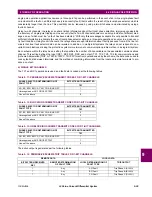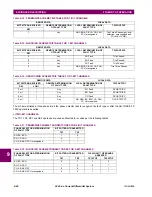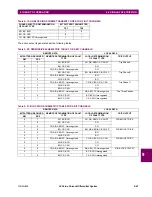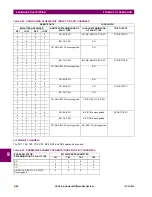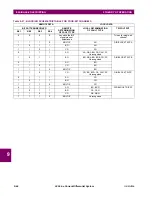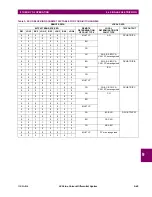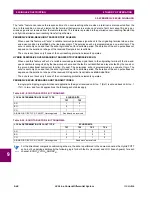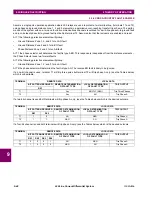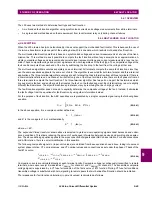
GE Multilin
L90 Line Current Differential System
9-49
9 THEORY OF OPERATION
9.6 FAULT LOCATOR
9
9.6FAULT LOCATOR
9.6.1 OVERVIEW
The L90 uses two methods to determine fault type and fault location
•
A multi-ended fault location algorithm using synchronized currents and voltage measurements from all line terminals.
•
A single-ended method based on the measurement from local terminal relay only during channel failures.
9.6.2 MULTI-ENDED FAULT LOCATOR
a) DESCRIPTION
When the L90 ordered has in-zone functionality, it does not support the multi-ended fault locator. This is because the use of
the in-zone transformer replaces part of the existing data with in-zone data, which restricts multi-ended fault location.
The multi-ended fault location method is based on synchronized voltage and current measurements at all ends of the trans-
mission line. This method makes it possible to compute the fault location without any assumptions or approximations. A
single composite voltage and single composite current signal represent voltage and current measurements at any line ter-
minal. These composite voltage and current signals are non-zero regardless of the fault type. The composite voltage at the
fault can be computed from each end of the line by subtracting the line drop to the fault from the voltage at that end.
The multi-ended algorithm executes separately on each terminal. All terminals compute the same fault location, since they
use the same equations applied to the same set of data. The algorithm is executed for both two-terminal and three-terminal
applications. The three-terminal algorithm executes at each terminal that has information from all three terminals. If there is
a communications failure on one channel, it will affect only one of the three terminals, since there are fault phasors from all
three terminals to compute the fault location. The three-terminal algorithm has two parts: one part that determines which
line segment is faulted, and another part that locates the fault on the faulted segment. Each terminal may report a slightly
different fault resistance. The algorithm achieves greater accuracy by removing the line charging current.
The fault location algorithm does not need to explicitly determine the composite voltage at the fault. Instead, it eliminates
the fault voltage from the equations for fault location by using other information instead.
For the purpose of fault location, the ABC quantities are represented by a single composite signal using the following base
equation.
(EQ 9.41)
In the above equation, b is a complex number defined as:
(EQ 9.42)
and b* is the conjugate of b, or mathematically:
(EQ 9.43)
where
= 45°.
The
expanded Clarke transform
shown above is selected to yield non-zero operating signals under balanced and unbal-
anced conditions. This allows reducing the amount of exchanged information between devices and avoiding phase selec-
tion. The above defining equation applies to the wye connection of signals under ABC phase rotation. For delta connections
and ACB rotation, there is a small modification in this equation.
The following composite signals in (in per-unit values) are obtained from base equation shown above, taking into account
system phase rotation, CT nominal values, and VT nominal values and connections as set under the phase VT bank of the
first 87L source.
(EQ 9.44)
Composite currents are calculated locally at each terminal locally. Composite voltage is continuously transmitted to remote
terminals, where upon receipt it is labeled as
V
REM
1(
X
)
for channel 1 and
V
REM
2(
X
)
for channel 2. The transmitted composite
voltage signal is supervised by a VT fuse fail condition of the first source of 87L function. During VT fuse fail conditions,
transmitted voltage is substituted with zero, signaling to remote peers that multi-ended fault location should be inhibited.
The impedance for fault location calculation (in per-unit values) is calculated as follows.
S
X
1
3
---
2
S
A
bS
B
b
S
C
b
1
j
tan
b
1
j
tan
I
LOC A B C
I
LOC X
I
REM
1
A B C
I
REM
1
X
I
REM
2
A B C
I
REM
2
X
V
LOC A B C
V
LOC X
Summary of Contents for UR Series L90
Page 652: ...A 16 L90 Line Current Differential System GE Multilin A 1 PARAMETER LISTS APPENDIX A A ...
Page 772: ...B 120 L90 Line Current Differential System GE Multilin B 4 MEMORY MAPPING APPENDIX B B ...
Page 802: ...C 30 L90 Line Current Differential System GE Multilin C 7 LOGICAL NODES APPENDIX C C ...
Page 812: ...D 10 L90 Line Current Differential System GE Multilin D 1 IEC 60870 5 104 APPENDIX D D ...
Page 824: ...E 12 L90 Line Current Differential System GE Multilin E 2 DNP POINT LISTS APPENDIX E E ...
Page 834: ...F 10 L90 Line Current Differential System GE Multilin F 3 WARRANTY APPENDIX F F ...
Page 846: ...xii L90 Line Current Differential System GE Multilin INDEX ...





